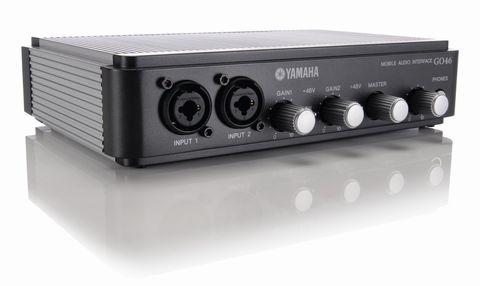Yamaha seem to make practically every type of musical instrument known to man, and they've also been keen to position themselves in the computer-based music production market (as evidenced by their purchase of Steinberg a couple of years ago). As such, the launch of the GO46, a FireWire audio interface, came as no great surprise.
However, there isn't exactly a shortage of portable, multichannel, bus-powered, cross-platform audio interfaces on the market, and most of them are of pretty high quality. That being the case, you have to wonder what Yamaha have done to make their I/O box stand out.
Inside the box
Open up the GO46's bulky packaging and you find a compact interface made of rugged metal and toughened plastic. The front panel features two dual-purpose jack/XLR inputs with individual gain pots and phantom power switches, a dual-purpose master volume switch for the two stereo pairs of audio outs (pushing it in switches between the two) and a headphone jack with level control. Turn the unit around and you'll see four outs and four ins arranged in stereo pairs (all are on 1/4-inch jacks), S/PDIF I/O (at up to 24-bit/96kHz), two FireWire ports and old-school MIDI I/O.
There's plenty of connectivity, then, but how does the GO46 sound? Pretty good, as it turns out. The quality is fine for both studio and on-the-road use - some nice 24-bit/192kHz converters are onboard - and we noted both great clarity and low noise (even when driving the levels). The preamps, too, are decent for a unit of this price, enabling you to push the levels quite high. They aren't world-class, obviously, but they're certainly more than adequate for most users.
The GO46 starts to look even better when you consider its ergonomics and options. The build-quality really is excellent, with the knobs and jacks feeling firm, durable and professional. This is an interface that you'd feel confident about taking on the road in a rucksack - if you're a mobile digital DJ, you should definitely consider it (particularly if you also dabble in remixing and production). The GO46 just feels more solid and reliable than a lot of the dedicated DJ interfaces, and because it doesn't arse around with any extra time-code translation, the price is much keener.
In performance
The GO46's control application offers plenty of options in order to cater for many different types of user. The unit is plug-and-play compatible, but you need to run the control panel in order to customise the internal routing. To give an example, you can route the DAW signal to the outputs either as separate signals (ie, four true independent outputs) or as a control room monitor and main output (very useful in certain recording situations). You can also route the analogue inputs directly to the outputs or blend them with the DAW signal, enabling players to monitor their performance without all the latency that routing via their DAW would introduce.
It's definitely worth reading the manual to find out how all the routing options work - we spent the first ten minutes wondering why an identical signal was coming out of both stereo pairs and the headphone output! It would be remiss of us not to mention the respectable software that ships with the GO46. It might not be the reason that you'd buy this interface, but the inclusion of a package that contains Steinberg's Cubase LE, HALion SE and Groove Agent SE certainly isn't to be sniffed at either.
Verdict
So what's the final verdict? Well, as we said, Yamaha have entered a pretty busy market, so this is a tough one. On the build quality score, the GO46 rates very highly for a sub-£300 unit, but the actual sound quality isn't that special (though it's hardly what you'd call poor, either). Things start to improve again when you factor in the flexible routing options and slick software, and it's also good to find that there's a power supply in the box (useful in those moments when the FireWire bus can't put up with any more abuse).
Ultimately, something about the GO46 just feels right. If you're a digital DJ with your head screwed on right, you'll want to have more than one stereo out so you can split your mix through multiple channels on the hardware, and you won't find many better options at this price. Furthermore, if you make studio and/or field recordings, you'll really appreciate the connectivity and routing options. In fact, the only people who might not be so tempted are the 'do it all in the computer' studio bods who rarely record anything, though at this price, even they might consider it.


